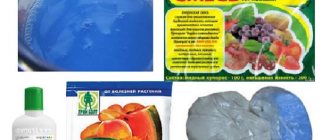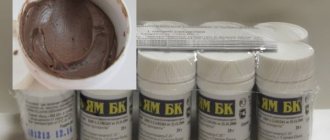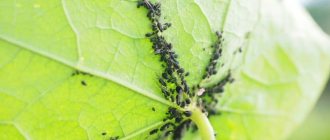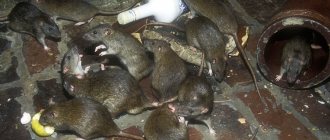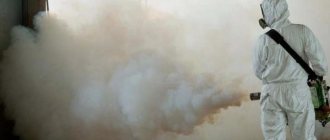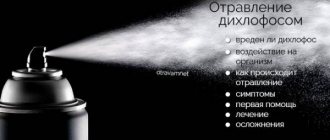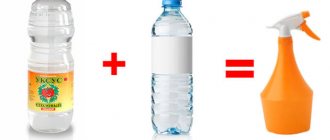What is Bordeaux mixture and how does it work?
The drug consists of 2 components - copper sulfate and calcium hydroxide (in amounts of 960 and 900 g per kg), the product has the formula CuSO4 • 3Cu(OH)2. You can prepare the liquid yourself or buy it ready-made in a bottle. Acts as a protective fungicide, bactericide and ovicide, has a contact effect.
Bordeaux mixture is a unique fungicide. It can be used against fungi on various crops - vegetables, berry bushes, flowers, ornamental shrubs, melons and citrus fruits.
The action of the fungicide is based on the effect of copper on fungi. With preventive and therapeutic effects, copper disrupts the normal course of processes in cells, as a result of which fungi die. The fungicide begins to act 2 hours after it appears on the surface of the plant; the protective effect on crops lasts for 7-12 days.
Advantages and disadvantages
Before preparing and using the product, it is necessary to consider all the positive and negative effects of its influence on garden crops.
- productivity in the fight against a large number of diseases;
- availability of components;
- nice price;
- long term of influence;
- versatility;
- ease of manufacture;
- cannot cause calcium starvation;
- holds well on shoots and foliage.
- toxicity;
- prohibition on even minimal deviation from instructions;
- cumulative effect that has a negative impact on crop growth.
Of course, a harmful and ineffective drug will not be held in high esteem by farmers for several decades.
Area of application of the product and its composition
In gardening, crops are treated by spraying. The liquid is used mainly for treating gardens and vineyards in early spring and autumn and throughout the season; vegetable crops are also processed in season.
The product is used to treat trees and shrubs against a number of fungal diseases: fruit rot, scab, clasterosporiosis, rust, spotting, moniliosis, curl, coccomycosis, anthracnose, septoria; grapes are sprayed against oidium and mildew.
Bordeaux mixture is used on garden crops against late blight, peronosporosis, macrosporiosis, anthracnose, hernaria, cercospora, and rust. It has a gentler effect on plant tissue compared to synthetic products and does not leave burns. The liquid can also be sprayed on flowers grown indoors, as well as treated inside greenhouses, preparing the space for the growing season.
What is Bordeaux mixture used for?
Typically, a fungicide is used to effectively combat various fungal infections on apple and pear trees. So, using Bordeaux mixture, you can try to fight scab, fruit rot, leaf spots of these crops, and even rust.
Photo: Treating apple trees with Bordeaux mixture.
On stone fruit crops, in particular cherries, plums and cherry plums, using Bordeaux mixture, you can fight gray mold, coccomycosis, moniliosis and even clasterosporiasis.
You can try to get rid of fungal infections on various berry bushes, on grapes and even on roses, for example, with diseases such as anthracnose, grape mildew, septoria, stem cancer and infectious burn.
Cooking rules
It is easy to prepare Bordeaux mixture yourself from copper sulfate and fresh lime. Two types of solution are made: 1% and 3%; to prepare them you need to take 100 g of vitriol and lime or 300 g of both substances. Dilute them in 5 liters of water separately, and then mix them in a bucket, you get 10 liters in total. Mix the two solutions in this order: vitriol into the lime mortar, and not vice versa. If you do the opposite, when you pour lime, that is, an alkali into an acidic environment, the reaction can be violent, and there is a high probability of burns. Pour in the liquid slowly and carefully, stirring constantly.
Correct preparation is checked with litmus paper: it should not turn red. If it turns red, the solution has an acidic reaction, which can be reduced by adding lime water.
You can take a simpler route: buy ready-made liquid in a bottle. It is produced in 100 ml bottles. This is a concentrate, it is diluted in 10 liters in an amount of 100-250 ml. The drug is stored for 2 years. The prepared liquid cannot be stored; it must be used immediately.
See also
Instructions for use and composition of the fungicide Metamil MC, dosage and analoguesRead
Expert opinion
Zarechny Maxim Valerievich
Agronomist with 12 years of experience. Our best country expert.
Ask a Question
The finished liquid is effective and easy to use, which is why it is still used to this day in summer cottages and on private farms.
How to properly prepare Bordeaux mixture
Bordeaux mixture, the preparation of which is not particularly difficult, although less toxic than copper sulfate, still take care of your safety when starting to work with the mixture:
- carry out all actions in protective clothing, as well as gloves, goggles, and a respirator;
- Do not use the containers in which the solution was mixed in the future for other needs;
- Dispose of the remaining solution by burying it in the ground outside the garden area.
The drug must be prepared on the day of use. If gardening work is postponed to the next day, add 5-10 g of sugar to it to preserve the fungicide.
So, 1% Bordeaux mixture - step-by-step preparation of the solution:
Step 1. Prepare 2 non-metallic containers (glass, enamel or earthenware will do) with a volume of at least 10 liters.
Step 2. Dissolve 100 g of copper sulfate in 1-1.5 liters of hot water. Then gradually pour in 4 liters of cold water.
Step 3. In the second container, extinguish 100-150 g of quicklime, pour in 1-1.5 liters of cold water, then gradually pour in 4 liters of cold water.
Step 4. Mix each solution thoroughly.
Step 5. Pour the copper sulfate solution in a thin stream into the container with the lime solution (but not vice versa!) and mix gently.
You should have a bright blue liquid.
Check to see if there is too much vitriol in it. To do this, lower a stainless iron object (for example, a nail) there and look carefully: if a copper coating appears on the metal, then you need to add a little more lime solution.
To prepare a 3% solution of Bordeaux mixture, use 300 g of copper sulfate and 450 g of lime.
Why we need Bordeaux mixture and how to dilute it, we figured it out, now let’s get down to the question of how to properly use this drug on your suburban area.
Work time
Bordeaux mixture is used in spring and autumn as a prophylactic agent, and also during the season as a therapeutic agent.
in autumn
Trees and shrubs are sprayed after the leaves have fallen; in this case, trunks and all branches are subject to treatment. Since you need to make a concentrated solution, which can burn the leaves, you need to choose the time in the middle or towards the end of autumn.
in spring
Spraying of stone fruit trees that are sensitive to copper should be done exclusively in spring or autumn and should not be sprayed in summer. Other fruit and berry bushes can be treated in the summer, but the last spraying should be done no later than 2-3 weeks before harvesting the fruits.
In spring you can spray before buds open and leaves appear. A weak solution can be treated before flowering, if necessary.
Instructions for use of the solution
Spraying of shrubs, vegetables, trees is done in such a way as to wet all the leaves on both sides, all branches, trunks and stems. It is convenient to use a spray bottle. On average, 2-10 liters are consumed per tree, per shrub and per 1 square meter. m of vegetable beds - 1.5-2 liters.
Spraying in spring and autumn is done at temperatures above 5 °C. It is advisable to work early in the morning or in the evening, on a day when there is no sun, wind or rain. The final spraying against fungi should be carried out no later than 2 weeks before harvesting.
For pears, apples and quinces
It is used on young and mature fruit-bearing trees. In spring and autumn, use a 3% solution, before flowering - 1%. The interval between sprayings is 1-1.5 weeks, the last one is carried out 2 weeks before harvesting in the garden.
Grape
Bordeaux mixture helps against mildew and an equally dangerous disease - oidium. As with trees, the vine is sprayed in spring or autumn, before the leaves appear or after they fall. If necessary, it can be treated in the summer, with a pause of 1-.5-2 weeks, the last spraying should be done 15 days before the grape harvest.
Gooseberries and currants
In spring, for bushes, use the drug with a concentration of 3%, in the period before flowering - 1%. Take a break between treatments of 1.5-2 weeks. In mid-summer, when the berries are collected, one more treatment should be carried out - with a 3% solution.
Strawberry and raspberry
For these crops in the spring, a solution of strong concentration is used with a consumption of 1.5 liters per 10 square meters. m. After harvesting the berries, spraying is done, but with 1% liquid.
Tomato
A highly concentrated solution is not suitable for all vegetables. Apply 1%. They consume 1-1.5 liters per 10 square meters. m. The maximum number of treatments is 4 per season.
Cucumbers, watermelons and melons
For cucumbers, the consumption of the drug is 1.5-2 liters per 10 square meters. m., spraying frequency – no more than 3 per season. Consumption for melons and watermelons is 1 liter for the same area.
See also
Instructions for use and mechanism of action of fungicide TitanRead
Potato
For potatoes, the product consumption is 1-1.5 liters per 10 square meters. m. The maximum number of sprayings is 4 per season.
Decorative shrubs and flowers
In spring and autumn, shrubs can be sprayed with a 3% solution, in summer - with a 1% solution in a volume of 1-2 liters per plant. For flowers, use only a weak solution.
Onion
Onions on turnips are sprayed with 1% liquid up to 3 times per season. Green onions cannot be treated with this product.
Beet
The number of sprayings is no more than 3 times per season, with a consumption of 1 liter per 10 square meters. m. Concentration – 1%.
Insects and plants in the fight against aphids
Biological methods of control are considered one of the most effective. Once you place a ladybug on your property, it will immediately begin to absorb harmful guests. In just one day, one assistant will eat two hundred parasites.
Nurse insects that will help rid the area of an aphid colony:
- lacewings;
- flower flies;
- Red ants do not feed on aphids, but are enemies of black ants. This species is considered an ally of aphids; such insects are not afraid of fire, as they hide deep in the soil. Red ants will help destroy black ants.
Sparrows, tits, and linnets are biological weapons against pests. It is important to attract all these creatures to the site and not create situations that are dangerous for their existence. For example, many beneficial insects overwinter in fallen leaves and dry grass. Ladybugs will love corn tops. To burn it all means to deprive of helpers, to provide aphids with a poorly protected garden.
Video about the use of ammonia and laundry soap.
A powerful remedy against aphids is plants. It is worth planting henbane, tobacco, dandelion, basil, wormwood, garlic, onions, horseradish, cornflower, and shepherd's purse on the site. Petunia, begonia, nasturtium, the beloved mallow, bird cherry, and viburnum, on the contrary, attract aphids, so they should be planted as far as possible from fruit crops.
Precautionary measures
Due to the rather pronounced toxicity of the product (class 2 for humans and class 3 for bees), you should work with the liquid in thick clothing, wear gloves on your hands, and a mask and goggles on your face. Drinking, eating anything, and smoking are prohibited. After finishing spraying, wash your hands and face with soap. If drops get on the skin or mucous membranes, rinse them with running water.
It is prohibited to combine Bordeaux mixture in the same solution with FOS and agents that decompose in an alkaline environment. The industrially produced drug is stored for 2 years, the solution is not stored longer than 1 day. It must be used on the day of preparation. The very next day it loses its properties.
When processing beds and gardens, you need to try to ensure that the liquid does not fall on the ground; copper can accumulate in the soil and negatively affect the plants in the future.
Copper sulfate for treating trees and bushes
This drug is extremely useful for seedlings of fruit trees and shrubs. It not only treats and prevents diseases, it also disinfects plant cuts. This solution is popularly known as a powerful antiseptic and is popular among gardeners. Moreover, many professionals claim that in gardening work one cannot do without copper sulfate, and it is just as obligatory and necessary in everyday life, as, for example, a shovel or garden shears.
By the way, the drug is used not only for disinfectant and antiseptic purposes, but also as a microfertilizer that replenishes copper reserves in the soil.
